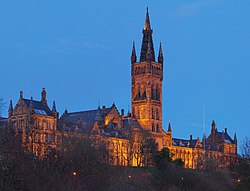References
- ↑ Leigh Rayment's Historical List of MPs – Constituencies beginning with "G" (part 1)
- ↑ Craig, F. W. S. (1989) [1977]. British parliamentary election results 1832–1885 (2nd ed.). Chichester: Parliamentary Research Services. p. 616. ISBN 0-900178-26-4.
- 1 2 Debrett's House of Commons and the Judicial Bench 1916
- 1 2 3 4 5 6 Craig, FWS, ed. (1974). British Parliamentary Election Results: 1885-1918. London: Macmillan Press. ISBN 9781349022984.
- 1 2 3 4 5 6 Whitaker's Almanack, 1907
- 1 2 3 4 5 6 Craig, F. W. S., ed. (1977). British Parliamentary Election Results 1832-1885 (e-book) (1st ed.). London: Macmillan Press. ISBN 978-1-349-02349-3.
- ↑ "The Representation of the Glasgow and Aberdeen Universities" . Dundee Courier . 22 September 1876. p. 3. Retrieved 30 December 2017– via British Newspaper Archive.
- ↑ "Universities of Glasgow and Aberdeen" . Banffshire Journal and General Advertiser. 9 November 1869. p. 1. Retrieved 13 February 2018– via British Newspaper Archive.

